 Click here to go back to main page.
Click here to go back to main page.
doings
September 2012

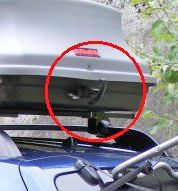 1 September -
Matt (who came home yesterday after a fortnight at college in Grimstad) moved today into his new flat, just over the fjord north of Stavanger.
(click picture, left, for photos).
It's about the fourteenth time he's moved from home, so there wasn't a great sense of drama about the proceedings.
At least, not until we got as far as Ålgård (the small town of mini-roundabouts on the way towards Sandnes),
when the contents of the roofbox decided that they wanted a better view and mischievously popped open the lid.
One drinking glass foolishly made a bid for freedom during our circumnavigation of a roundabout, but realised its mistake when it met the road.
It would be terribly unfair on Matthew (who was responsible for packing the car) if we were to suggest who might be to blame in this respect -
especially in the light of the visible detail in the photo (right) of our departure.
There was no other excitement and Matt is now safely deposited in his new seaside home.
1 September -
Matt (who came home yesterday after a fortnight at college in Grimstad) moved today into his new flat, just over the fjord north of Stavanger.
(click picture, left, for photos).
It's about the fourteenth time he's moved from home, so there wasn't a great sense of drama about the proceedings.
At least, not until we got as far as Ålgård (the small town of mini-roundabouts on the way towards Sandnes),
when the contents of the roofbox decided that they wanted a better view and mischievously popped open the lid.
One drinking glass foolishly made a bid for freedom during our circumnavigation of a roundabout, but realised its mistake when it met the road.
It would be terribly unfair on Matthew (who was responsible for packing the car) if we were to suggest who might be to blame in this respect -
especially in the light of the visible detail in the photo (right) of our departure.
There was no other excitement and Matt is now safely deposited in his new seaside home.
His new address there is:
Bruveien 246
4158 Bru,
Norway.
4 September -
This evening, a Sea King rescue helecopter and divers from the rescue services were called in to search the coast near the Norwegian town of Halden
for a man who apparently had fallen into the sea at a small harbour.
After some hours of fruitless searching, someone who knew the missing man was rather surprised to bump into him on Halden's main shopping street.
The man was equally surprised that half of Norway's rescue services were currently searching the sea for his body.
"I only went for a pee into the harbour", he is reported to have said, blushing rather, "and then went back a different way".
One way and another, he made quite a splash.
Did you know that it's just 400 years since Norway was invaded by Scotland?
This is a story that is very little known in Britain, mainly because its place in history is as one of the most
harebrained military operations ever to originate there. It is however very well known in our old home - the fjord between Måndalen and Åndalsnes -
because that was where the landing took place.
It's hardly current news, of course, but in honour of the 400th anniversary I'll tell you the story.
At the very beginning of the 17th century, the political
situation in Scandinavia was tense. Norway was
technically a part of Denmark. The Danes would have
liked also to include Sweden in its empire, while the
Swedes’ ambition for their own empire included
Northern Norway. Armies and weapons were assembled.
In 1612 some Scottish army officers undertook on their
own account an operation to enlist a mercenary army to
fight for the Swedes. They visited prisons and offered
prisoners instant freedom if they joined the army, and
they press-ganged unfortunate passers-by. It’s a little
puzzling that these officers were assembling an army for
the “wrong” side: King James I (whose brother was the
King of Denmark) was rather cross when he found out,
and the whole motley crew had to skip the country in
rather a hurry.
Of course, there were two major weaknesses with the
plan. Firstly, to get from Scotland to Sweden you have
to go through Norway, and there is a certain
awkwardness about the idea of walking through Norway
with a band of recruits for the Swedish army which was
coming to fight the Norwegians. Secondly, when a few
officers have recruited three shiploads of murderers and
assorted prisoners whose only interest was getting out of
prison, and passers-by who had probably just been
enjoying a merry evening with a bottle of whisky before
waking up in the middle of the North Sea with a
hangover and an army number, it would be asking for
trouble to give them all firearms. So the entire army
(none of whom had any military experience anyway)
was to walk unarmed through enemy country.
The ships aimed for the port of Åndalsnes (still a popular
destination for British tourist ships). As they entered the
Romsdalfjord, they met a fisherman and asked for
directions. “We have these boatloads of soldiers who’ve
come to fight you. Could you show us where to tie up,
please?” The fisherman, called Peder Klungnes,
somehow persuaded the Scots that they couldn’t land at
Åndalsnes but he invited them to land at his farm
(Klungnes) and then walk round the bottom of the fjord
(Isfjorden) to Åndalsnes, thus delaying the Scots by at
least half a day. It’s thought that having recognised the
vistors as Scottish he told them that the landing fees in
Åndalsnes were a rip-off and he could do them a better
deal.
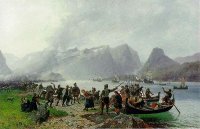 (Right - click for enlargement - Adolph Tidemand's slightly inaccurate painting of the landing: they actually landed at the Klungnes farm on the opposite side of the fjord).
(Right - click for enlargement - Adolph Tidemand's slightly inaccurate painting of the landing: they actually landed at the Klungnes farm on the opposite side of the fjord).
In any event, as soon as the army had left, Peder
Klungnes sent his dairy maid in his fastest rowing boat
over to Åndalsnes to warn the men of the town to take up arms to repel the invaders. Being a fairly laid-back
town, however, the inhabitants decided simply to offer
the visitors coffee and point out the road towards
Sweden. They did, however, send a messenger up to the
next town, Dombås, asking them to deal with the
approaching army. The men of Dombås were also a
fairly relaxed bunch who got coffee and waffles ready.
“For Sweden, you take the E6 southbound and turn left
at Ringebu”. Some of the Dombås men, however, got
on their horses and rode down the Gudbrandsdalen
Valley, collecting others from the villages along the way.
At a place called Kringen, the old road southwards
squeezes itself for a couple of miles into a narrow gap
between the steep mountainside and a fast-flowing river.
A group of people travelling along the road would have
to walk single file. The villagers hid themselves amongst
the trees on the mountainside, posting a girl called Guri
with a horn up the mountain, from where she could see
the approaching army. Once the Scots had all spread out
along the narrow track, Guri sounded her horn and the
locals came out and shot them all. The whole troop was
wiped out or captured, although one or two of the Scots
must have quietly slipped away during the march south
because for years afterwards there were stories of wild
men living in the forests around Dombås, playing
strange wailing music on dead octopuses and popping
into the local Spar to ask whether they stocked haggis.
What is really interesting about this story, however, is
that whenever the Scots met with the locals (with Peder
the fisherman, with his dairymaid and with an old lady
they met along the road) they had conversations. In
other words, ordinary people from 17th-century
Scotland spoke more or less the same language as the people around Åndalsnes.
(This is one of the stories in Tim's memoirs).
5 September -
I (Tim) am in Iceland this evening, after a long and rather confusing series of flights.
Although the booking company mentioned that it was necessary to take a local flight to Bergen before catching the Iceland Air flight to Reykjavik, they forgot to mention that the flight also went via Trondheim.
And I hadn't realised that not only is Iceland an hour behind Norway but it also hasn't adopted summer time, which means a 2-hour time difference
(which goes some way towards explaining the disparity between the flight times and the given flight duration for the return journey).
In Reykjavik it's raining and 9 degrees, and the road from Keflavik (which for some reason sounds more like something you coat a frying pan with than the name of an airport) to Reykjavik was
very long, grey and flat.
And then, Iceland has a tradition of annoying the British (just remember the cod wars, Icesave and distributing volcanic ash through European air space).
And they spell everything with strange curley letters.
Curiously, from a Norwegian point of view it's perfectly possible to read Icelandic if you've had enough to drink
("Fylltu inn í formið hér fyrir neðan og við munum senda þér verðtilboð innan 2 virkra daga")
but when spoken it's just a jumble with the occasional and bizzarly unexpected recognisable word.
So Iceland doesn't seem to make a very good first impression, but I'm hoping for better things tomorrow.
After finally and gratefully collapsing into my hotel room I switched on the TV to see what Icelandic television was like.
It was half-way through an episode of the Sweeney.
 7 September -
If Iceland doesn't make a fantastic first impression it makes an excellent second impression
(click photo, left, for picture sequence).
The sun shone on the mountains, and Reykjavik proved to be a very pleasant, clean, fresh city.
I visited the famous Blue Lagoon and agree with my brother and sister-in-law: the former that it's not worth all the hype and the latter that you've got to see it anyway.
Iceland, the most sparsely-populated country in Europe, reminds me a bit of Northern Norway 25 years ago.
It's the country with the lowest level of crime in Europe.
Outside Reykjavik the wilderness starts. Many of the cars in the city are big 4x4s with extra-large "monster" wheels fitted (and in many cases, spades strapped to the sides) - a witness to hard winters without snow clearing on the smaller roads.
Many excellent organs, including a fantastic instrument in Hafnarfjörður church by Dresden-based Kristian Wegscheider - who I was also able to talk to for the first time (after exchanging many emails over the last couple of years)
And everyone I've met has been really pleasant and friendly.
A couple of hundred yards down the road from my hotel, Iceland has this evening beaten Norway 2-0 at football.
But they weren't showing that on the television - they were showing an episode of Minder.
7 September -
If Iceland doesn't make a fantastic first impression it makes an excellent second impression
(click photo, left, for picture sequence).
The sun shone on the mountains, and Reykjavik proved to be a very pleasant, clean, fresh city.
I visited the famous Blue Lagoon and agree with my brother and sister-in-law: the former that it's not worth all the hype and the latter that you've got to see it anyway.
Iceland, the most sparsely-populated country in Europe, reminds me a bit of Northern Norway 25 years ago.
It's the country with the lowest level of crime in Europe.
Outside Reykjavik the wilderness starts. Many of the cars in the city are big 4x4s with extra-large "monster" wheels fitted (and in many cases, spades strapped to the sides) - a witness to hard winters without snow clearing on the smaller roads.
Many excellent organs, including a fantastic instrument in Hafnarfjörður church by Dresden-based Kristian Wegscheider - who I was also able to talk to for the first time (after exchanging many emails over the last couple of years)
And everyone I've met has been really pleasant and friendly.
A couple of hundred yards down the road from my hotel, Iceland has this evening beaten Norway 2-0 at football.
But they weren't showing that on the television - they were showing an episode of Minder.
16 September -
 We've not reported much from the Norwegian news lately - mainly because there hasn't been much to report.
There are the usual September reports of sub-zero temperatures, of the amount of snow here and there,
of mountain roads closed due to bad weather, of warnings to car drivers not to drive on roads over a couple of thousand feet without winter tyres -
all sounding rather surprised and aggrieved that it's daring to snow, as though it doesn't do it every September.
Otherwise the news has featured such dramatic headlines as "No to henhouse" (a local authority refused planning permission)
and "See what Dag Tore found in his bus" (stowaway goats in the luggage compartment)
(photo, right - click for enlargement).
We've not reported much from the Norwegian news lately - mainly because there hasn't been much to report.
There are the usual September reports of sub-zero temperatures, of the amount of snow here and there,
of mountain roads closed due to bad weather, of warnings to car drivers not to drive on roads over a couple of thousand feet without winter tyres -
all sounding rather surprised and aggrieved that it's daring to snow, as though it doesn't do it every September.
Otherwise the news has featured such dramatic headlines as "No to henhouse" (a local authority refused planning permission)
and "See what Dag Tore found in his bus" (stowaway goats in the luggage compartment)
(photo, right - click for enlargement).
18 September -
We've also not reported a lot from our doings - but this time because there's too much to report.
Tracy is swamped by meetings - and is leading the funeral of her secretary tomorrow (so there's an extra person's work to do as well).
Tim came home from Iceland and straight to a day's lecturing at Kristiansand, followed by a week of Bishop's quinquennial visitation
interrupted only by a lecture-recital for the Norwegian organ Festival, a culture evening, another day of lectures and preparations for a concert in Larvik in a couple of days,
a consultancy report to write for the university and ...
you get the picture.
Not much time to write anything here, I'm sorry.
It's always an experience to travel in the remoter parts of Finnmark -
those vast open spaces where 6-year-olds chase their reindeer on their snow scooters and almost anything can happen.
The locals grow up with a profound understanding of nature - like something out of Crocodile Dundee.
So it was today that a man was out hunting elk near Karasjok when he heard a bear in the bushes and shot it.
Would you recognise the sound of a bear, with sufficient confidence to take a pot shot at it without looking to check?
Be impressed.
And then read the man's account of the event in the newspaper, in which he admits that he pulled out his fancy mobile,
checked on Google for mp3s of bear noises and did a bit rapid revision before pulling the trigger.
On reflection it's even more like Paul Hogan.
22 September - A day of activity.
Tracy is organising and painting her ground-floor hobby room, Tim and Andrew are in the forest chopping down still more trees (taking advantage of a day of glorious sunshine),
Katie is away on a camp and "our" eagle (it doesn't regard itself as such, but it's the one that lives on the cliffs high up in our forest) has been doing some dramatic hunting very close to the house, with an appreciative audience.
 23 September -
Adding to the wildlife theme, we awoke this morning to see a deer leading her three fawns across the closest field, just outside the kitchen window.
And on the way to church this morning there was a red squirrel (they're all red ones around here) that just sat and really wouldn't get out of the way - I had to stop and ask it move off the road.
23 September -
Adding to the wildlife theme, we awoke this morning to see a deer leading her three fawns across the closest field, just outside the kitchen window.
And on the way to church this morning there was a red squirrel (they're all red ones around here) that just sat and really wouldn't get out of the way - I had to stop and ask it move off the road.
Ørsdalen's now-traditional annual mobile harvest festival went from farm to farm in the valley this afternoon (click photo, above left, for picture sequence).
As usual, it was well attended (certainly a lot better attended than a "static" service in the school would have been) and fits the valley ethos of everyone being involved.
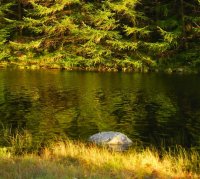 Today, though, is the first day since 19 March when we've technically got less daylight than places that are further south.
We're noticing that it's no longer quite light when we get up, just before 6, and there's a long way to go yet before the shortest day in three months!
Today, though, is the first day since 19 March when we've technically got less daylight than places that are further south.
We're noticing that it's no longer quite light when we get up, just before 6, and there's a long way to go yet before the shortest day in three months!
We've said before that our lake (like the nearby lakes) is different every day.
On my way home from taking Andrew back to his flat after the weekend,
the sun was low in the sky, bringing out the early Autumn colours
(click photo, right, for 3 pictures).
 27 September - I’ve just got on the train at Nordagutu. (Photo, left - click for enlargement. I'm tempted to claim it was taken today, but it wasn't).
Nordagutu is a village in Telemark which consists of a railway station,
a railway platform, a railway siding and a little bridge under the railway line.
In all fairness there’s also a shop, most of whose customers are presumably people like me, waiting for a train.
Apparently some 350 people live in Greater Nordagutu, although from the station platform there’s no sign of any houses. So what was I doing there?
Last night I played a concert in the south-coast town of Larvik. It was a very pleasant concert, (photo, below right - click for enlargement)
though the highlight of the trip was meeting (and staying overnight with) some old friends who we knew in Rauma in the early 1990s
and who we’ve not seen for many years. To get to Larvik I flew from Stavanger to nearby Torp airport –
some 40 minutes on one of Widerøe’s little Dash-8 planes – but there wasn’t a convenient flight back today so I’m returning by train:
an 8-hour rail journey as well as a couple of extra hours to collect my car from Stavanger airport.
27 September - I’ve just got on the train at Nordagutu. (Photo, left - click for enlargement. I'm tempted to claim it was taken today, but it wasn't).
Nordagutu is a village in Telemark which consists of a railway station,
a railway platform, a railway siding and a little bridge under the railway line.
In all fairness there’s also a shop, most of whose customers are presumably people like me, waiting for a train.
Apparently some 350 people live in Greater Nordagutu, although from the station platform there’s no sign of any houses. So what was I doing there?
Last night I played a concert in the south-coast town of Larvik. It was a very pleasant concert, (photo, below right - click for enlargement)
though the highlight of the trip was meeting (and staying overnight with) some old friends who we knew in Rauma in the early 1990s
and who we’ve not seen for many years. To get to Larvik I flew from Stavanger to nearby Torp airport –
some 40 minutes on one of Widerøe’s little Dash-8 planes – but there wasn’t a convenient flight back today so I’m returning by train:
an 8-hour rail journey as well as a couple of extra hours to collect my car from Stavanger airport.
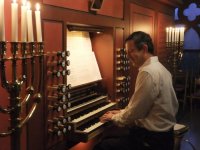 Although all the towns are along the coast (did you know that every town in Norway other than Hamar and Lillehammer is on the coast –
a hangover of the days when all travelling was done by sea?), the ”south-coast” railway line runs miles inland,
calling in at places like Nordagutu instead of in the centres of population.
This seems strange, but the main reason, apparently, was in order that if there should be a war, the strategically-important railway line wouldn’t be blown up
by attacking ships. Although work to build the line began in the 1860s, and the sections at both ends
(Oslo to Drammen and Egersund to Stavanger) were finished in the 1870s, the line as a whole wasn’t completed and opened until 1944 –
and then it was the occupying Germans who did it, as is the case with so much of Norway's infrastructure.
But because the line goes nowhere near any of the towns,
there’s a succession of little picturesque branch lines, including the Bratsberg line which runs, or rather, ambles, from near Larvik
and up to Nordagutu (that's the train shown on the photo - not today's train, of course, but it hasn't really changed much). I spent the half hour’s wait for the main-line train admiring Nordagutu’s very pretty railway station,
together with a statue just by platform 1 of a local folk musician with a pair of something that looked rather like bears at his heels.
The waiting room featured excellent pictures of the most famous event in Nordagutu’s history – a major train crash in 1950,
with many fatalities. Just to put you in the mood for your onward train journey.
But now I’m settled into the comforts of the mainline train for the next few hours.
Plenty of room, free coffee on tap, a power socket for my computer,
a good internet connection so that I can post this entry and above all a constantly-changing view of hills and lakes.
Although all the towns are along the coast (did you know that every town in Norway other than Hamar and Lillehammer is on the coast –
a hangover of the days when all travelling was done by sea?), the ”south-coast” railway line runs miles inland,
calling in at places like Nordagutu instead of in the centres of population.
This seems strange, but the main reason, apparently, was in order that if there should be a war, the strategically-important railway line wouldn’t be blown up
by attacking ships. Although work to build the line began in the 1860s, and the sections at both ends
(Oslo to Drammen and Egersund to Stavanger) were finished in the 1870s, the line as a whole wasn’t completed and opened until 1944 –
and then it was the occupying Germans who did it, as is the case with so much of Norway's infrastructure.
But because the line goes nowhere near any of the towns,
there’s a succession of little picturesque branch lines, including the Bratsberg line which runs, or rather, ambles, from near Larvik
and up to Nordagutu (that's the train shown on the photo - not today's train, of course, but it hasn't really changed much). I spent the half hour’s wait for the main-line train admiring Nordagutu’s very pretty railway station,
together with a statue just by platform 1 of a local folk musician with a pair of something that looked rather like bears at his heels.
The waiting room featured excellent pictures of the most famous event in Nordagutu’s history – a major train crash in 1950,
with many fatalities. Just to put you in the mood for your onward train journey.
But now I’m settled into the comforts of the mainline train for the next few hours.
Plenty of room, free coffee on tap, a power socket for my computer,
a good internet connection so that I can post this entry and above all a constantly-changing view of hills and lakes.
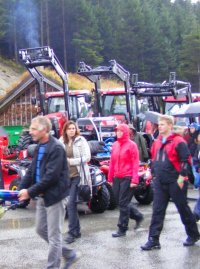 29 September - Annual agricultural fair in Vikeså. (Click photo, right, for picture sequence).
The event is traditionally held on the first full weekend of October.
We pointed out last year and the year before that
it always pours down on the first full weekend of October (whereas the weekends either side are always fine).
So this year the event was held a week earlier (also because sheep prices go down at the beginning of October).
It poured down more than ever.
29 September - Annual agricultural fair in Vikeså. (Click photo, right, for picture sequence).
The event is traditionally held on the first full weekend of October.
We pointed out last year and the year before that
it always pours down on the first full weekend of October (whereas the weekends either side are always fine).
So this year the event was held a week earlier (also because sheep prices go down at the beginning of October).
It poured down more than ever.
Comments
- Sue Bamford
- September 17th, 2012
Your home looks lovely and you all seen to be living a good life take care,Sue
- Tim
- September 17th, 2012
Thank you Sue - lovely to hear from you!

 1 September -
Matt (who came home yesterday after a fortnight at college in Grimstad) moved today into his new flat, just over the fjord north of Stavanger.
(click picture, left, for photos).
It's about the fourteenth time he's moved from home, so there wasn't a great sense of drama about the proceedings.
At least, not until we got as far as Ålgård (the small town of mini-roundabouts on the way towards Sandnes),
when the contents of the roofbox decided that they wanted a better view and mischievously popped open the lid.
One drinking glass foolishly made a bid for freedom during our circumnavigation of a roundabout, but realised its mistake when it met the road.
It would be terribly unfair on Matthew (who was responsible for packing the car) if we were to suggest who might be to blame in this respect -
especially in the light of the visible detail in the photo (right) of our departure.
There was no other excitement and Matt is now safely deposited in his new seaside home.
1 September -
Matt (who came home yesterday after a fortnight at college in Grimstad) moved today into his new flat, just over the fjord north of Stavanger.
(click picture, left, for photos).
It's about the fourteenth time he's moved from home, so there wasn't a great sense of drama about the proceedings.
At least, not until we got as far as Ålgård (the small town of mini-roundabouts on the way towards Sandnes),
when the contents of the roofbox decided that they wanted a better view and mischievously popped open the lid.
One drinking glass foolishly made a bid for freedom during our circumnavigation of a roundabout, but realised its mistake when it met the road.
It would be terribly unfair on Matthew (who was responsible for packing the car) if we were to suggest who might be to blame in this respect -
especially in the light of the visible detail in the photo (right) of our departure.
There was no other excitement and Matt is now safely deposited in his new seaside home.
 Click here to go back to main page.
Click here to go back to main page.







